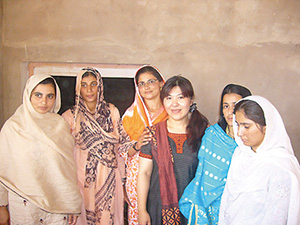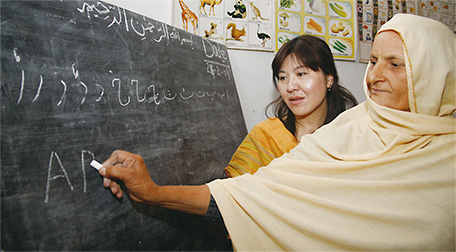Stories from the field 01
Giving people who missed out on an education a second chance
– Promoting a “Non-formal Education” in Pakistan

A teacher of literacy classes, female students, and Ms. Ohashi (center). (Photo: Chiho Ohashi)
Pakistan is the sixth most populous country in the world, with 180 million people, and the Punjab Province, located in the eastern part of the country, is Pakistan's most populous province. Although some cities in the northern part of the province have achieved industrialization and are thriving, many people still live in the province's southern agricultural regions, where they earn a living by farming, working in handicrafts-related jobs, and making craft products. The estimated literacy rate of Punjab Province residents is 62%, one of the lowest levels among all the countries of South Asia. Then again, literacy in the urban areas is said to be over 70%, while in the rural areas the literacy rate remains around 50-60%, indicating that this issue stems from problems the state faces in terms of education. Female education in particular is an issue here, due to reasons such as economic constraints like poverty, as well as local cultural practices that discourage women from going out of their homes or communities.
One woman is fighting against this situation in order to improve the literacy rate. She is Ms. Chiho Ohashi, a project advisor for JICA's “Non-Formal Education Promotion Project.” “Non-formal Education” generally refers to educational activities that take place outside of the framework of formal schooling. It provides learning opportunities to children who cannot otherwise go to school or who have dropped out of school, as well as to young people and adults who never had the chance to learn.
Ms. Ohashi became involved with Non-formal Education through previous jobs related to UNESCO. She has been working as an expert in Non-formal Education in Punjab Province since the preceding project that started in 2008. She commented, “Pakistan not only has a low literacy rate but also the second highest school dropout rate in the world. As a consequence of that, people are unable to receive the benefits of education or acquire information that could be useful to them socially and economically. They are robbed of their opportunities for social participation as citizens. Non-formal Education plays an extremely important role in giving these people a second or third chance.”
The fact that over 70% of the enrollees in Non-formal Education programs are women shows that the women of the region are placed in an environment that keeps them away from education. Ms. Ohashi pointed out, “Even if people here think that education is necessary, there are many poor households that believe that if anyone can be sent to school, boys should go first.” As represented by the case of Malala Yousafzai, the girl who appealed for the right of women to have an education in Pakistan and was shot by Islamic extremists, women continue to suffer prejudice and discrimination in Pakistan. In addition, there are issues with the way schools are conventionally operated, including the fact that schools are located very far away from homes, and lack separate women's toilets.
In order to actively accept more girls and women, the project in Pakistan has adopted a “doorstep approach” in which classes take place next door to homes. Local women that the girls are familiar with act as teachers, creating a safe environment in which females can participate without fear. The project does not limit itself to conventional ideas about what a school should be, and has quickly changed what were once meeting places in each village into places of learning.
“Since I am usually the only Japanese person working with this project, I have to adapt to a Pakistani way of working and negotiation to a certain extent. Fortunately, I am surrounded by excellent co-workers and local experts, and am able to move this project ahead by making full use of their skills and expertise. In order to secure a place for classes, it is indispensable that we first get the understanding and cooperation of local people, mainly the men.”

A female student of the adult literacy class. Although literacy classes are generally aimed at 15 to 35 year-old people, women older than that age group also attend the classes. (Photo: Chiho Ohashi)
The innovative methods of this project can be seen in the way it teaches and its educational materials. For example, “My Book,” a workbook inspired by the Maternal and Child Health Handbooks in Japan, is a unique item in which learners can learn to read and write while experiencing what it is like to keep their own diaries. “The learners write more and more on things that concern them, including their name, their date of birth, address, information about their family, and other information. It allows them to reaffirm their own identities and helps them develop pride and self-confidence.”
Ms. Ohashi explained that although learning how to read and write is merely an initial goal in order to progress further with learning, through the act of learning itself the girls and women are prepared to have a skill needed in order to solve a host of other issues facing the learners, including poverty, conflict, sickness, and natural disasters. In other words, through the process of learning, learners acquire “The capacity to survive and live through any hardship.” “The real pleasure of this project is that we get to see the change in people. The expressions of the girls and women change entirely. When I see how they develop a lot of confidence in themselves through learning and how they start finding much of interest in their communities, I can really feel the significance of education. When people are given the opportunity to learn, they begin to talk about their hopes for the future with so much joy and excitement.”
There is now high interest being expressed by other provinces in Pakistan and the neighboring country of Afghanistan for the non-formal education system and learning materials developed in this project. Through this project, the joy of learning is beginning to spread across even provincial and national boundaries.
Next Page >>
Main Text | Statictics and Reference Materials | Stories from the field | Master Techniques, From Japan to the World - | ODA Topics
